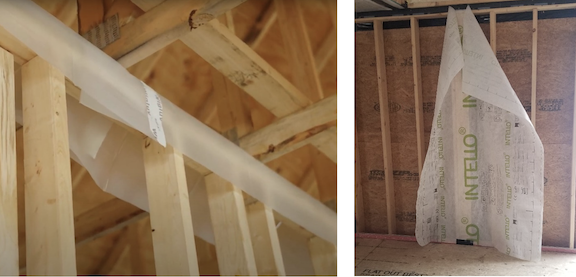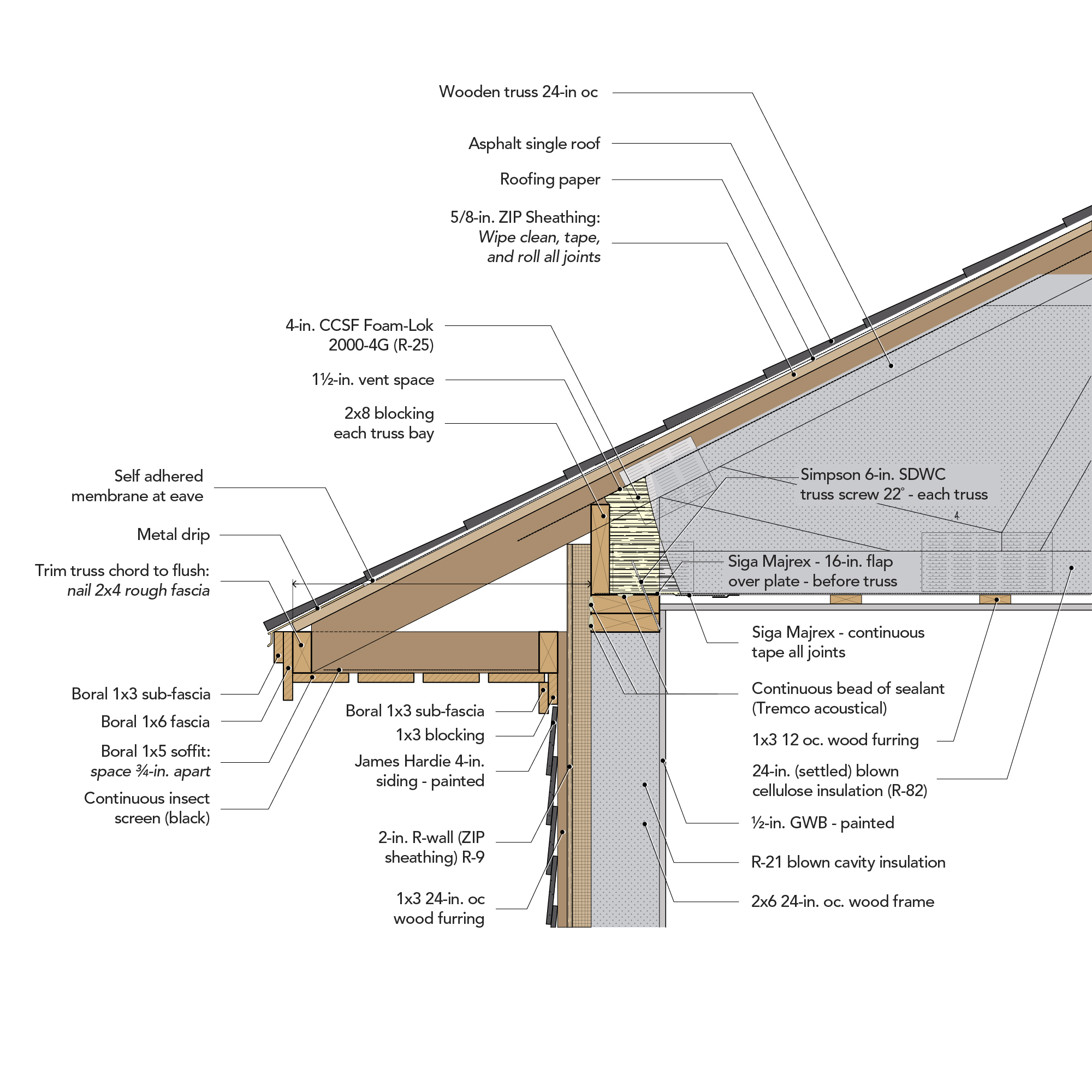
I’m from Minnesota, one of the few areas in the lower 48 that still regularly uses polyethylene sheeting as a vapor retarder. We’ve become very good at detailing these interior membranes for use as an air barrier. The average blower door test I conduct for new homes in my market is below 2 ACH50, most achieving these scores using only an interior air control strategy. In most cases, I don’t recommend using poly. Instead I suggest moving to a class II vapor retarder, (smart, variable, and responsive vapor retarders). These products can also be used for air control. Installation is similar in either application but there are some tricks to getting an effective interior air barrier. That’s what I’ll talk about here.
No matter which product is used, or whether it’s located outside, inside, or in the middle of the wall assembly, continuity is the key to an effective air barrier. You may remember the old song by Dem Bones…“The foot bone’s connected to the ankle bone, the ankle bone’s connected to the leg bone”… Well, it is exactly how an effective air barrier works—by connecting the foundation to the wall and the wall to the ceiling.

Think through the process
The most difficult part of interior air-sealing is the interior partition walls. Interior walls create lots of breaks in continuity both at the ceiling and where any interior wall connects to the exterior wall. Do all those walls need to be constructed before the roof framing is placed? The homes I test that have the lowest blower door numbers are designed so the roof is supported only (or mostly) by the exterior walls. This leaves one big…
Weekly Newsletter
Get building science and energy efficiency advice, plus special offers, in your inbox.

This article is only available to GBA Prime Members
Sign up for a free trial and get instant access to this article as well as GBA’s complete library of premium articles and construction details.
Start Free TrialAlready a member? Log in















12 Comments
Randy,
AIRFOIL electrical boxes are not available at this time. After 20 years it is time for a pause and reflection. I have been in contact with CSA on certification in both Canada and the US. The Canadian Step Code looks like it may be a fit for airtight boxes. Thank you for your coverage over the years, will keep you posted.
Doug
Doug,
I hope you do re-start production and get approval for Canada. They are an excellent solution.
Thank you, Malcolm and Randy
CSA has been very accommodating and quick to respond to my certification questions. I believe they would be good to work with. I took AIRFOIL as far as it could go with the current product offering. The resin we used for 20 years has been substituted for a like resin but may have required new UL testing and certification. Had considered CSA approval early on but the Canadian grounding standard is different than in the US.
Here is where things stand today. If we move ahead with CSA Certification it will take some reworking of our existing production molds. The best way forward as I see it would be to work with a molder/tooling company so all work could be done in house. I feel a Canadian company could best do this work and possibly have existing CSA inspections, although not mandatory.
Any links to molders/tooling companies in Canada would be appreciated. I have no experience and knowledge of how it works there. I was very fortunate to work with a fantastic molder in Maple Grove, MN, REO Plastics, Inc. They helped us early on get samples run and tools tweaked to get Underwriters Laboratoires certification. Much of the groundwork is laid for moving forward.
Doug
Thanks for the update, Doug, I should probably contact my supplier and order what they have.
Randy,
Thanks for the overview. Up here in what is probably the last large bastion of poly use, we sandwich the strips between the two top-plates on interior walls. That helps protect them against damage when the trusses go on, keeps the walls walkable, and limits the number of fasteners that penetrate them. The strips get lapped with the ceiling membrane in the same place on the side of the upper top-plate, whether they are locate above or below that plate.
What a great idea Malcolm, thanks for sharing.
Are interior air barriers a recommended approach? I thought that even in cold climates moving the air barrier to the exterior was fine: https://buildingscience.com/documents/insights/bsi-084-forty-years-of-air-barriers
frontrange,
It's hard to know which works best. Which one is more vulnerable to damage over time may depend on whether trades and house owners recognize them. One of the advantages of an interior membrane is it is easily identifiable and a separate component, although perhaps more difficult to repair. Exterior air-barriers give the benefit of not having to seal penetrations like electrical boxes in drywall. Houses with the primary air-barrier at the exterior still usually need a secondary interior one to stop convective air movement cycling through the stud bays.
I'm not sure the location or method matters much compared to how diligently it is done.
Thanks.
Is dense pack or mineral wool batts considered sufficient to prevent convective air movement?
frontrange,
The drywall itself is usually a pretty good secondary air-barrier without any further air-sealing measures, but yes - mineral wool or cellulose are more forgiving that fiberglass.
Interesting that ten years after that article, we aren't seeing the same pace of change. It feels like the rate of innovation in some basic areas of building has slowed down - maybe because what we are doing works pretty well?
I think innovation tends to come in waves, and in between the waves the rest of the industry catches up to the last set of changes. It takes a long time in construction to incorporate changes, see if they last over time, and spread the word of how they have performed.
We use aerobarrier to seal these final joints and up here it's around 2500/house this seams like a much more effective method and easier than trying to put air barrier behind interior walls I cant imagine trying to get my rough carpenters to do that.
Log in or become a member to post a comment.
Sign up Log in